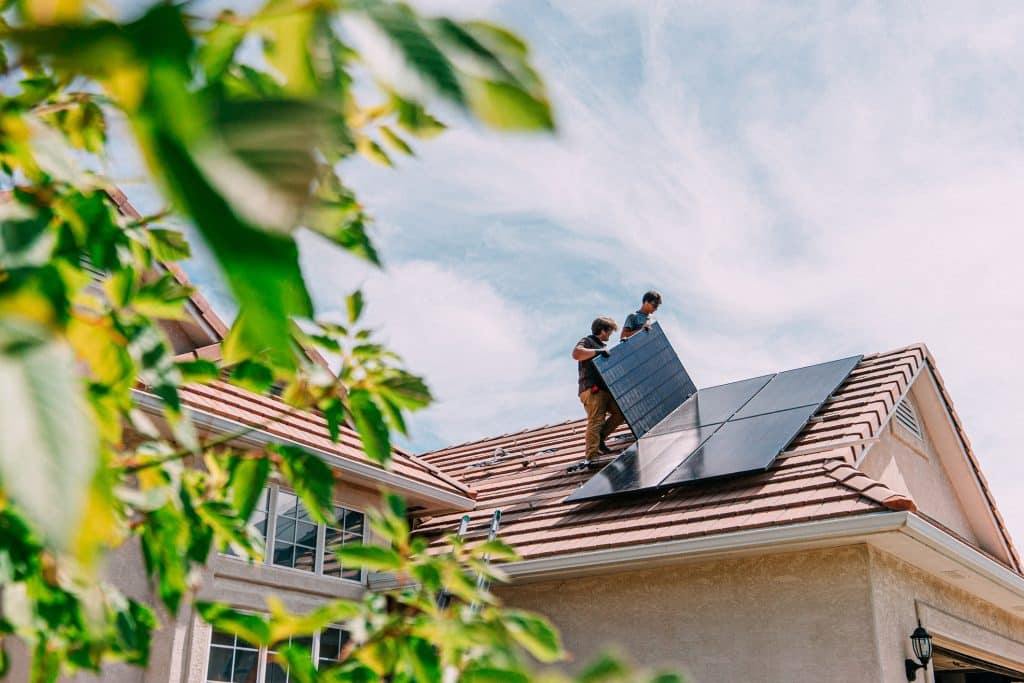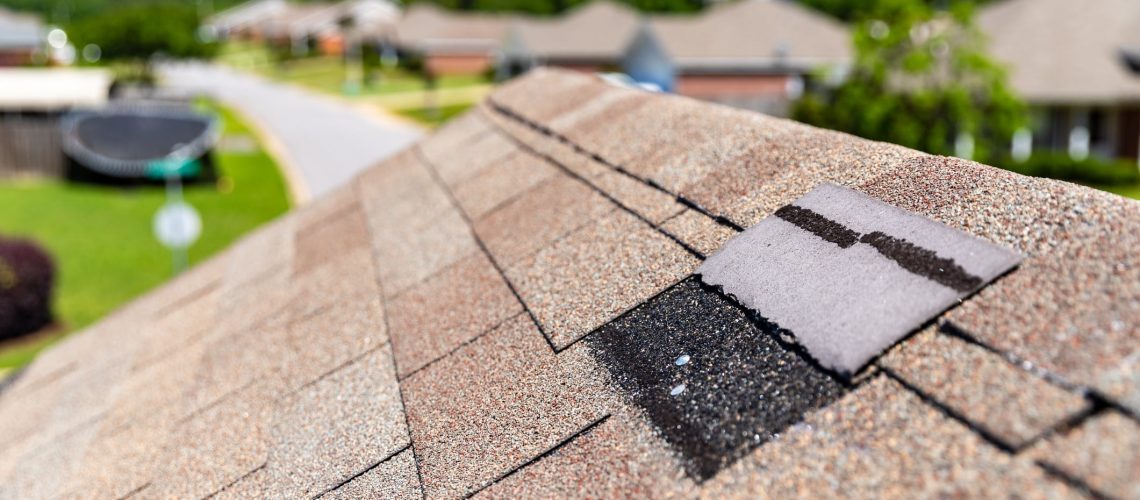Weather plays a major role in the durability and performance of your roof. In Alberta, where winters are harsh and summers are hot, roofing materials face unique challenges. Freezing temperatures, snow, rain and ice can cause cracks or warping, while intense sun and UV exposure can degrade materials over time. Hailstorms and high winds also contribute to damage.
How Alberta Weather Affects Roofing Materials
Alberta’s weather is unpredictable and extreme, which can strain roofing materials. The province experiences various weather conditions, from heavy snow and ice in winter to intense heat in summer, alongside strong winds and occasional hailstorms:
Winter (Snow and Ice)
Snow accumulation and ice dams can weigh heavily on roofs and cause leaks when the ice melts. This is particularly problematic for asphalt shingles, which can become brittle in freezing temperatures.
Summer (Heat and UV Exposure)
High temperatures and direct sunlight can cause materials to expand and contract, leading to cracks and other forms of wear. Roofing materials like wood shakes or asphalt shingles may degrade faster when exposed to prolonged sunlight.
Wind and Hail
Alberta also experiences strong winds and hailstorms, which can cause physical damage to roofs. Hail can crack tiles or break shingles, while high winds lift and displace roofing materials.
Spring and Fall (Rain)
These seasons bring heavy rainfall, resulting in water pooling on flat roofs, leading to leaks or structural damage.

Top 10 Roofing Materials and How They Are Affected by Weather
Let’s explore the top 10 roofing materials, highlighting how Alberta’s fluctuating climate impacts each one and learn insights into their strengths and vulnerabilities:
| Roofing Material | Impact of Weather |
| Asphalt Shingles | Vulnerable to cracking in freezing temperatures, damage from hail, and UV degradation in hot summers. Prolonged exposure to moisture can cause mould and algae growth. Shingles may curl or lift with high winds. Regular maintenance is needed to prevent wear, especially in Alberta’s fluctuating temperatures. |
| Wood Shakes | Prone to warping, cracking, and rotting due to moisture. These materials are also highly susceptible to mould growth and decay in humid environments. Wood shakes can fade,e or splinter with prolonged sun exposure, and snow accumulation can cause them to break under the weight. They need regular treatment to resist moisture damage and ensure long-term durability. |
| Metal Roofing | Extremely durable in heavy snow and high winds, offering significant protection from storms. Metal roofs are also effective at shedding snow and ice, which helps prevent leaks. However, metal roofs can be prone to denting from hailstorms, especially if the panels are thin. Metal roofing also reflects heat, which improves energy efficiency during hot summer months, making it ideal for Alberta’s hot summer days. |
| Clay Tiles | Clay tiles are incredibly durable and provide excellent heat resistance, making them a top choice for homes in sunny climates. However, they can crack or break under freezing or from heavy hail. The weight of snow can also cause the tiles to shift or crack if not properly maintained. Proper installation with adequate support is necessary to prevent these issues. |
| Concrete Tiles | Like clay tiles, concrete tiles are very durable but can crack in extreme cold or under the weight of heavy snow. They also withstand high heat well, making them suitable for Alberta’s summer temperatures. However, concrete can be heavy and require additional structural support for proper installation. Maintenance is necessary to ensure the tiles remain intact, especially in areas with extreme weather variations. |
| Slate | Extremely durable and resistant to weathering, with a lifespan exceeding 100 years. Slate roofs are not affected by UV rays or heat, making them perfect for both hot and cold climates. However, slate can be brittle, so impact from hail or fallen branches may cause cracking or shattering. Its heavy weight requires additional structural support. Regular inspections are important to identify any signs of wear or damage. |
| EPDM (Rubber Roofing) | EPDM is particularly resilient to cold temperatures, making it ideal for Alberta’s winter months. It is also highly water-resistant, reducing the risk of leaks in rainy conditions. However, EPDM roofing can degrade in prolonged sun exposure, leading to cracking or bubbling over time. This material is also susceptible to damage from sharp objects, making maintenance essential. |
| TPO (Thermoplastic Polyolefin) | TPO is a highly reflective roofing material that helps reduce cooling costs by reflecting UV rays. It is also resistant to water damage, making it ideal for Alberta’s heavy rainfall. However, TPO roofs can be susceptible to damage from hail and extreme UV exposure over time, causing surface degradation and cracks. It’s important to inspect TPO roofs regularly for signs of wear. |
| PVC Roofing | Known for its durability and resistance to moisture, PVC roofing can withstand various temperatures. It performs well in both hot and cold climates but can be prone to surface damage from prolonged UV exposure, causing brittleness or cracking. Hailstorms can also lead to punctures or cracks. Regular inspections and protective coatings can help extend the life of PVC roofing. |
| Green Roofs (Living Roofs) | Green roofs are great for managing stormwater and providing insulation. They help reduce urban heat islands and improve energy efficiency. However, they are prone to moisture-related issues like leaks or mould growth, especially in areas with high rainfall. Green roofs also require regular maintenance, including weeding, irrigation, and ensuring the drainage system works effectively. In Alberta, where snow can accumulate heavily, the added weight of snow may put additional stress on these roofs. |
How to Prevent Damage to Roofing Materials
Proper maintenance can help you preserve the lifespan of your roofing materials, regardless of Alberta’s harsh weather conditions. Follow these tips to prevent damage proactively
- Regular Inspections: Inspect your roof regularly, especially after severe weather events like storms or heavy snowfalls. Look for damaged shingles or tiles and replace them promptly.
- Clean Gutters: Clogged gutters can cause water to back up, leading to leaks or ice dams. Ensure gutters are debris-free and water flows properly off the roof.
- Trim Overhanging Branches: Trim trees and branches that could fall on your roof during a storm and cause damage to the roofing material.
- Roof Coatings: Consider applying a protective coating to asphalt shingles or metal roofing to extend their life and improve their resistance to UV rays, snow, and ice.
- Ice Dam Prevention: For homes in colder climates, installing proper attic insulation and ventilation can prevent ice dams, which can cause water to back up under shingles and cause leaks.
Specific Tips to Protect Different Types of Roofing Materials
Protecting your roof from weather damage starts with understanding how to care for different materials. Check out the table below for practical tips to prevent wear and extend the lifespan of your roof, no matter what type of material you choose:
| Roofing Material | Prevention Tips |
| Asphalt Shingles | Seal with a waterproof coating to resist UV damage. Regular inspections and maintenance are essential to check for wear, cracks, or missing shingles. Clean gutters and downspouts to prevent water backup, which could lead to leaks. Replace damaged shingles immediately to avoid further damage to the roof structure. |
| Wood Shakes | Apply a water-resistant treatment to prevent rot and mould growth. Regularly inspect the roof for damage caused by moisture or pests. Replace broken shakes to ensure the roof is watertight. Trim overhanging branches that could cause physical damage to the shakes. |
| Metal Roofing | Check seams regularly for leaks and reseal them as needed. Install snow guards to prevent snow and ice build-up, which could damage the roof or create leaks. Clean the roof surface regularly to avoid debris build-up, and inspect for any dents or scratches after hailstorms. |
| Clay Tiles | Ensure proper installation with adequate support to prevent shifting or cracking from snow weight. Inspect tiles after storms for cracks, chips, or damage from falling debris. Regularly check for moss or algae growth, which can accelerate tile degradation. |
| Concrete Tiles | Check for cracks and replace broken tiles promptly. Ensure proper installation and inspect for shifting tiles after heavy snow or wind. Regularly clean to prevent debris build-up and check for mould or moss. |
| Slate | Inspect for cracks, chips, or broken tiles. Replace damaged tiles quickly to avoid water penetration. Regularly check for moss or algae growth, which could damage the slate surface. |
| EPDM | Inspect for cracks or tears caused by sharp objects or sun exposure. Apply protective coatings to prevent UV damage. Clean the roof surface regularly to avoid debris build-up and maintain its waterproofing properties. |
| TPO | Inspect for signs of wear, especially after hail or heavy UV exposure. Regularly clean to prevent the build-up of dirt or algae, which can affect the roof’s performance. |
| PVC Roofing | Apply a protective UV coating to prevent brittleness. Inspect regularly for cracks, especially after hailstorms, and replace damaged areas quickly. |
| Green Roofs (Living Roofs) | Regularly check the drainage system and ensure the plants are healthy. Trim excess growth, replace dead plants, and monitor for leaks or mould. |
Looking Forward to Roof Renovation?
Choosing the right roofing material for your home or business is essential for both protecting your property and ensuring long-term durability. By understanding how different materials respond to extreme weather and selecting one that suits your needs, you can protect your investment and maintain the safety and comfort of your home for years to come.
If you want expert help with your roofing needs, book a free quote today, and we’ll take it from there!


